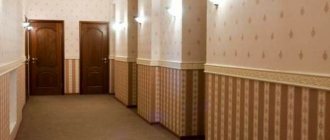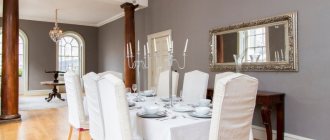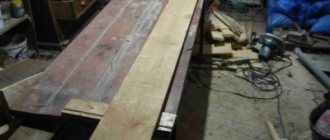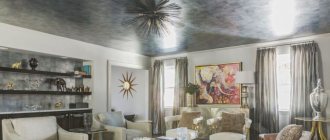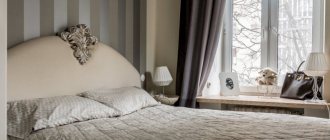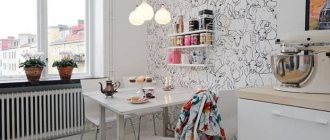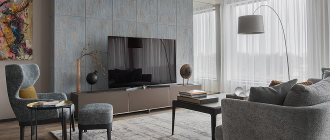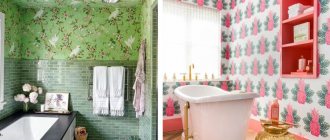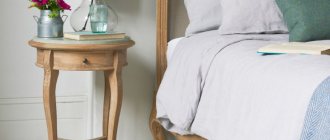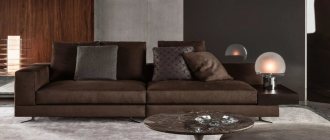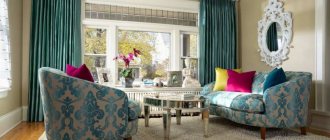Everyone can afford affordable and aesthetic wall decoration. The paper covering will look great in any room. It is enough to choose the right color, pattern, type and size of the canvas to create a beautiful image and make the room cozy and comfortable to stay in. But how to choose wallpaper so that it fully meets all the requirements and meets the wishes without violating the design intent. To do this, you will need to take into account the individual characteristics of each type of material, the level of lighting and other multiple design nuances.
What to consider when choosing wallpaper
The main function that wall canvases should perform in a residential building is decorativeness. The basic decorative element in the form of narrow or wide stripes hides minor defects in the walls and serves as the background of the room. It is easier to keep the walls and ceiling clean; some types of wallpaper can be washed and vacuumed without fear for the integrity of the pattern.
Choosing suitable canvases for the kitchen or living room from a huge assortment is not easy. First of all, you need to take into account the type of room and its features. Even for the most low-traffic and dust-free room, the linens must be of high quality and functional. Selection must be made taking into account the following factors determining durability:
- Environmental Safety;
- Material density;
- Moisture resistance;
- Ability to adhere tightly to any surface;
- Lightfastness;
- Easy to care for;
- Abrasion resistance;
- The ability to absorb noise and allow air to pass through.
Choice of material and type of wallpaper
When purchasing several rolls of wallpaper, you need to evaluate their characteristics in expanded form. It is enough to stretch each one several meters to make sure that the pattern is even and the shades match. Each room has its own type of wallpaper. When choosing canvases, you should take into account their appearance, color scheme and features. The following types of wallpaper can be glued in apartments and houses:
- Vinyl. A decorative layer of vinyl is attached to a paper or non-woven base. The protective coating and dense base make the material strong and durable. A large selection of colors and textures allows them to be used for any living room and bathroom. Due to the maximum similarity of patterns with wood, leather, stone, vinyl wallpaper will harmonize perfectly with any natural material. The disadvantage is the impermeability of air through the top layer, the release of toxic chemical elements by some types.
- Paper. The simplest option for decorating ceilings and walls is made from one or two layers of paper. They can be smooth, textured, with a three-dimensional pattern, or corrugated. Depending on the weight of the roll, its quality is determined. The heavier the product, the better it is. The advantages of paper wallpaper include accessibility, low price and lightness. Disadvantages: poor presentation, limited variety of designs, fragility. Average service life is up to 5 years.
- Non-woven. Popular, expensive canvases combine the positive qualities of paper and vinyl wallpaper. High-density multi-layer rolls consist of cellulose and connecting materials. The wear-resistant surface almost always has a grooved pattern. More often, non-woven wallpapers are produced in light colors, which allows you to paint them yourself. The base contains an adhesive layer, so the material is easy to stick to any surface.
- Textile. The canvases have a unique structure. The top layer of improved drapery is made of viscose, linen, silk. The wallpaper is soft to the touch, looks unusual and discreet. Modern products can last up to 10 years. The disadvantages include the ability to fade under the influence of ultraviolet radiation, the absorbent properties of the material, and the retention of unpleasant odors. Dust is attracted to the surface, leaving stains from splashes when washing floors.
- Acrylic. Budget vinyl canvases. The bottom layer in contact with the wall is made of paper, the top, decorative layer is made of foamed acrylic. The fabrics do not prevent air penetration, have insufficient strength and a short service life.
- Liquid. The application technique of wallpaper is similar to decorative plaster. They may look different on the wall. It all depends on the composition and additional components. The base can be silk, cellulose, cotton. Acrylic dye, glitter, pieces of mother-of-pearl, mica, and various threads are used as additives. Using liquid wallpaper, you can create a seamless, vapor-permeable surface on any plane. Damage in any area can be easily restored. Disadvantages - the possibility of dry cleaning only, the need to prepare the walls before applying the liquid mixture.
- Natural. Plant wallpaper is preferred by eco-style lovers. The canvases are made from bamboo, jute, reeds, papyrus, cork, wood veneer, and some types of seaweed. It is also possible to combine several varieties. Natural finishes are not suitable for all rooms. It is most often used as a decorative accent in the recreation area, in the bedroom at the head of the bed, or in a dark hallway. Disadvantages: inevitable joints due to narrow rolls, fragility, high price.
- Photo wallpaper. Canvases with a panoramic pattern or images of individual elements can be paper, vinyl or non-woven. An unlimited number of options allows you to create a cozy atmosphere in the room and personalize the interior. You can make custom wallpaper with any image. Disadvantages - high cost, painstaking gluing, quick boring of the design.
- Paintable wallpaper. Canvases with a structured pattern are produced in white, which allows you to color them to your taste. Wallpaper can be smooth or textured, on paper, vinyl, or fiberglass. For each type of material you need to select a specific paint. Water-based, acrylic, latex compositions are used.
Color, pattern and texture
To create a stylish interior with an expressive design, you need to highlight the walls and make bright accents. Textured canvases can look completely different. When choosing wallpaper, the color and style of the furniture should be taken into account. Textural and color balance should not be disturbed. To highlight the accessories and furniture in the room, choose wallpaper in neutral tones. Plain flat or embossed ones are suitable. For rooms with a low level of light, the windows of which face the north side, you need to choose canvases in warm colors.
The endless variety of wallpaper designs can be divided into several main groups. Canvases without a pattern are neutral and create the desired depth of perception. Flower wall decoration will decorate the most empty wall. Stripes and lines fit perfectly into every style. Patterns and monograms are suitable for any room. Paintings, wall clocks, and photo frames will look great against the backdrop of unobtrusive leaves and twigs.
When decorating a living room, you should understand that the color of the wallpaper will be the main one, occupying the largest space.
Style
You can transform a room using any type of canvas. In order for the design of the room to be stylistically consistent, it is necessary to choose the right wallpaper. The following destinations are popular:
- Antique style. Suitable canvases imitate wall paintings, depicting historical events and nature. The joints are often decorated with polyurethane stucco and molding.
- Baroque, Rococo. Palace-style canvases can be of different colors. The only condition is the absence of straight, curved lines. Textile options with a characteristic shine and light refraction effect would be appropriate.
- Classicism. Laconic, moderate wallpaper colors strive for symmetry. The walls look overly pompous. Combining canvases horizontally is allowed.
- East style. Bright, contrasting design can be monochromatic, with minor red inserts or drawings of birds and trees. Photo wallpapers with cherry blossoms look good.
- Rustic. Country, Provence, and Jouy interiors accept pasting the walls with floral canvases. To avoid excessive variegation, I use plain canvases with simple textures without shine.
Natural room lighting
The color perception of the human eye is greatly influenced by the type of lighting. For darkened rooms, light wallpaper is more suitable, when rooms flooded with light will look beautiful and soft with green, pistachio, and blue wall decoration. Beige, peach, pink, and light green can be considered universal colors.
According to psychologists, each shade has a certain effect on the human psyche. If you need to make the walls dark, bright, you need to choose a tone that is one step lighter in the palette of the expected result.
You should also remember that the smaller the room, the brighter it should be. If there is a lot of greenery opposite the windows and there is a sunny side, this will be noticeable on the tone of the paintings. A brick wall or any surface painted in a dark color will be reflected on the interior in a light orange color.
Size and other features of the room
You need to choose wallpaper for each room separately. It is necessary to take into account not only the purpose of the room, but also the size, degree of illumination, and consistency in style with the overall decor. Light colors create the illusion of spaciousness and visually increase the space, so such canvases are ideal for small square rooms. A convex, three-dimensional pattern can only do harm. It is better to use smooth plain fabrics or with small colors or patterns.
In free rooms and studio apartments that are not overloaded with furniture, you can combine several shades, decorate them vertically with different types of wallpaper, and place accents on certain walls. Bright canvases with large geometric patterns will help narrow the room.
Types of wallpaper
In the recent past, only paper products existed in the construction market, which had virtually no competition. That is why, in order to choose wallpaper for a room, it was not necessary to take into account many nuances. The selection of the necessary material was reduced mainly to the determination of external indicators, which also did not differ in great variety. Now there are a sufficient number of products that have significant differences in characteristics.
Paper options
These products have still not lost their popularity; at the moment there are varieties that are suitable for a specific situation:
- Simplex, which is a single-layer product that does not have significant features. Used primarily for quick cosmetic renovations to rental properties.
- Duplex is multi-layered. It is suitable for children's rooms or highlighting certain areas.
Please note that none of the options are durable or wear-resistant.
Vinyl products
They consist of two layers: a base, which can be paper or non-woven, and a front covering - foamed vinyl, applied in the form of a pattern. The following varieties are distinguished:
- Heavy vinyl. It has a high density and textured pattern, which allows you to hide significant surface imperfections, so there is no need to carefully prepare the walls.
- Textured vinyl materials. They create a visual imitation of natural stone or plaster. This option is used mainly in classic interiors.
- Vinyl with special embossing. The product has proven itself well for rooms with high levels of sunlight.
Thus, vinyl roll products make it possible to select depending on the characteristics of the rooms.
Non-woven options
Many craftsmen and designers note that this is probably the best wallpaper. This statement is based on the properties of the material, among which the following stand out:
- Vapor permeability.
- Environmentally friendly.
- Resistant to many influences, including shrinkage.
- A wonderful decorative component.
Glass wallpaper
The choice of this type is based on the excellent performance qualities of such wallpaper. They are well suited in cases where there is a need or desire to constantly update the interior. The fact is that the coating can be painted multiple times.
Which wallpaper should you choose?
When choosing rolled products, you need to rely on three main parameters:
- Price. Paper ones are considered the cheapest, followed by vinyl and non-woven varieties. Glass wallpaper and other less popular types close the list.
- Resistance to various influences. Here it is necessary to highlight non-woven and vinyl options, as well as glass wallpaper. Naturally, paper materials do not have similar properties.
- Easy to install. It is quite easy to cover any wall with non-woven wallpaper; the glue is applied exclusively to one surface. Other options require greater accuracy and compliance with a number of conditions.
On a note! Choosing the right roll materials is not always easy; sometimes it is necessary to maintain a balance between price and quality.
Tips for choosing wallpaper for different rooms
The material for wall decoration should not only have an attractive appearance, but also quality characteristics suitable for a particular room. Waterproof canvases are used for finishing rooms with high humidity. Washable, durable wallpaper is used in rooms where there is a high risk of contamination. With the help of photo wallpapers and products made from natural materials, zoning and separation of workplaces from recreation areas are successfully carried out.
For the living room
The hall is usually the largest room in a house or apartment. The living room has a wide window opening and a lot of natural light, so it is better to choose wallpaper in cool shades - blue, light yellow, green. Peach and beige colors are suitable for darkened rooms. Monochrome colors are rarely used, only when necessary to emphasize the originality of the style.
When choosing a pattern, the size of the room is taken into account. The material of the canvas must be resistant to abrasion and ultraviolet radiation. The best option for a spacious living room is non-woven fabrics, photo wallpaper, or their combination.
For the bedroom
The rest and sleep room should have a calm environment. Wallpaper in pastel colors with a dim pattern will help provide this. If there are thick curtains on the windows, then these can be simple paper, natural canvases. It is possible to decorate with wallpaper in dark colors, especially if the owners suffer from insomnia.
Small and large geometric shapes, flowers, leaves and branches will look good in the bedroom. Liquid wallpaper is used to decorate the area at the head of the bed. In a small area, textured wallpaper without additional decor in the form of paintings and photo frames would be appropriate. The relief texture will emphasize the play of light and shadow, which will make the room more spacious.
For kitchen
The main criterion when choosing wallpaper for the kitchen is resistance to moisture and ease of care. Textile, natural, and paper options are definitely not suitable for this room, as they quickly deform in conditions of high humidity. It is better to give preference to vinyl, acrylic options, and glass wallpaper.
The color of wallpaper in the kitchen depends on its size. The color of the floor, ceiling, layout, and design features of the headset are also taken into account. The finishing material must also be vapor-permeable in order to have time to dry between cooking. The ability to repaint will greatly simplify renovations, which are carried out more often in the kitchen than in other rooms.
For children's
Canvases for a children's room should be selected taking into account the age of the child. For very young children, natural, environmentally friendly paper wallpaper in pastel colors is suitable. A light color scheme will not irritate, but will only help you fall asleep quickly and be in a good mood.
For older children, the ideal option would be to decorate with photo wallpaper with fairy-tale, cartoon characters. Teenagers can already participate in choosing colors and patterns. Parents can help their child determine his personal psychotype and similar color scheme. It is better if these are monochromatic canvases to give the child the opportunity to decorate the room on their own with photographs, garlands, and posters.
Since preschool children can damage and paint wallpaper, you should not buy expensive rolls during this period. It is better to update the decoration and refresh the room more often.
For the hallway
Fans of a pleasant background covering should pay attention to liquid wallpaper with a decorative sheen. This design will make a darkened room bright and attractive. Contaminated areas can be easily removed with a spatula and replaced with a new layer.
You can visually increase the space of the corridor using plain light-colored canvases based on vinyl or acrylic. The pattern is chosen based on the size and other features of the room. For self-pasting, heavy non-woven wallpaper is suitable, which can be adjusted directly on the wall. A high-traffic room is rarely equipped with natural light sources, so there is no need to worry about the paintings fading.
Wallpapers: will they be easy to care for?
Any finishing material needs care, and wallpaper is no exception. Dust accumulates on them, they get dirty when touched, and small children love to use them as a canvas for drawing. Therefore, when choosing wallpaper, you must first of all pay attention to whether it will be easy to care for.
According to this principle, wallpaper can be divided into regular, washable, moisture-resistant and super-washable.
- Regular wallpaper - dry cleaning only, for example with a soft brush and vacuum cleaner. Moisture ingress leads to damage: the pattern is washed off and the wallpaper material itself is destroyed. This applies to paper wallpaper, as well as almost all types of fabric wallpaper.
- Moisture-resistant wallpaper can be wiped with a damp cloth, without using detergents, only to remove dust.
- Washable wallpaper can be washed, as the name suggests. To do this, you can use non-aggressive detergents, for example, a solution of laundry soap.
- Super-washable wallpaper can be washed with aggressive detergents and use hard brushes. Neither the design nor the texture of such wallpaper suffers.
Simple wallpaper is perfect for dry rooms, and super washable wallpaper can be used for kitchens and bathrooms.
Calculation of the number of rolls
In order to accurately calculate the required number of rolls, it is necessary to take measurements in a room with perfectly smooth walls. You should take into account the texture of the canvas, the size of the pattern, and the need to adjust it. Niches, arches, openings must be taken into account in the calculations. You can take measurements in several ways:
- Calculation of the perimeter and number of stripes. The total perimeter of the room is measured, minus the size of the window and door openings. The resulting value is divided by the width of the rolls and, if necessary, rounded up. This figure is then divided by the pre-calculated number of strips per roll.
- Calculation of the area of the surface to be pasted. Precise, economical method suitable for large areas. Measure the perimeter of the room and multiply it by the height of the ceiling. Calculate the area of wallpaper in one roll. Then the area of the room is divided by the area of the material in one roll.
- Using an online calculator. There are many sites that allow you to use the calculation service for free. To get the result, just enter the dimensions of the rolls, wall parameters, and the width of the edges in the appropriate fields.
Briefly about the main thing
The living room, as the main room in the house, needs especially careful design, and wallpaper makes a significant contribution to the overall impression. To ensure that the finish fits harmoniously into the overall design, when choosing, pay attention to the material of manufacture and the qualities associated with it: durability and ease of use. It is also useful to take into account the features of the hall: its size and location relative to the cardinal directions.
Knowing the advantages and disadvantages of the material will help you narrow down your search and shift your attention to the choice of color and pattern. They are evaluated taking into account the style of the living room, not forgetting personal preferences. If you can take into account the color of the furniture, putting the interior together will be much easier.
Ratings 0
Symbols on wallpaper
Canvases of any type are marked according to a single standard. Drawings and pictograms on the label indicate important characteristics of the wall covering. The designations are deciphered as follows:
- Wave icon - indicates care options and degree of moisture resistance.
- Sun designation - reflects light fastness and degree of fading.
- Marking with arrows - indicates the method of combining the canvases.
- Icons with a brush will help determine the gluing method and the location of application of the composition.
- A picture of a wall with a peeling sheet indicates the method of dismantling the covering.
- Straight and vertical wavy lines indicate multi-layered fabric.
- The crossed out flame indicates fire resistance.
Which glue to choose
A specific glue is suitable for gluing each type of wallpaper. Manufacturers indicate this information on rolls. There are also universal mixtures that can be used for all types of fabrics. But you must adhere to the rule - the heavier the finishing material, the thicker the glue should be.
Wallpaper mixtures for wallpapering can be sold in dry or thickened form, ready for use. Some strips have a self-adhesive side. It is enough to moisten them with water and lean them against the wall.
All adhesive mixtures have almost the same composition. Manufacturers achieve different characteristics due to changes in proportions. Cellulose derivatives are used as a basis. To increase adhesion and moisture resistance, polyvinyl acetate is added. Antiseptics and fungicides protect against fungus and mold.
What types of wallpapers are there?
To make the right choice, you need to know the types of wallpaper and their purpose, so as a logical explanation it is necessary to touch on this topic.
Of the two varieties, the more familiar to anyone is roll wallpaper - fabric and paper based.
Liquid wallpaper is one of a number of modern technologies and is supplied to stores in plastic buckets.
In this case, it’s worth talking in more detail about the varieties of roll wallpaper familiar to everyone from childhood.
Paper wallpaper - its pros and cons
They became popular many decades ago. When choosing paper wallpaper, you need to know their positive and negative properties:
1. Pros:
- Affordable price;
- Environmental friendliness;
- A light weight;
- Easy to stick
2. Cons:
- Over the years they lose their color;
- Prone to deformation when exposed to a humid environment
But, despite such indicators, these wallpapers are still considered in demand. How to glue them correctly...
Advantages of vinyl wallpaper
A very common modern type of wallpaper, which is distinguished by its versatility:
- Increased moisture resistance;
- Unique clarity of drawing;
- Perfectly imitate other materials - brick, stone, paving stones, etc.;
- Easy to clean;
- High strength;
- No tendency to deform or fade;
- High wear resistance
Details in the article: How to properly hang vinyl wallpaper, as well as their types
Due to their immunity to moisture, they are perfect for the kitchen.
The advantages of non-woven wallpaper
This type of wallpaper consists of natural fiber mixed with cellulose or polyester. In most cases, non-woven fabric is the main part of vinyl coating, but it is often used as a separate covering and has a number of positive properties.
- Volumetric texture;
- Softness;
- Smoothness;
- Can be painted several times;
- This wallpaper is easy to paste: just coat the wall with glue and you can glue it right away;
- After drying, they do not shrink and the seams will not come apart
A special type of texture makes it possible to choose wallpaper with any image, and then repaint it when you want to update the room. Rules for decorating a room.
Textile wallpaper - its features
These wallpapers are considered a privileged class due to their high cost and novelty. This variety is distinguished by its characteristics, which must be taken into account when choosing them:
1. Positive:
- Nice texture;
- Highly decorative;
- Durability;
- Strength;
- Excellent cleaning properties;
- lie flat;
- They have no seams;
- Easy to lay on the wall;
- Ease of pattern adjustment
2. Negative:
- More expensive than other types of wallpaper;
- Can easily get dirty;
- Absorbs moisture and is therefore not suitable for wet areas;
- Like any fabric, it easily absorbs odors that are then difficult to get rid of;
- Dust accumulates in the space of the fabric base
How to choose the perfect wallpaper: materials and conventions
Most often, textile wallpaper requires a paper base, after which it must be laminated. Silk or cotton is used as a decorative layer. They are especially in demand among true connoisseurs of beauty and are designed to enhance the interior of the bedroom, giving it a special charm.
How to properly prepare walls for wallpapering
The walls are prepared for better adhesion and removal of fungus and other microorganisms. In order for the coating to last longer, the surface must be leveled as much as possible. First of all, you need to remove the old finish. Then primary priming is carried out to disinfect the surface and prevent moisture absorption.
At the next stage, all cracks and depressions are sealed with gypsum mortar. Convexities are erased with sandpaper. Repeated priming is carried out for better adhesion of the wallpaper to the walls. When preparing surfaces yourself, it is important to adhere to this sequence.
How to choose a wallpaper pattern?
The variety of wallpaper designs is impressive, but choosing from a large selection is very difficult. At first you want everything, then you want nothing. You can quickly get tired of the selection process, and as a result, buy what is closest to the exit. Therefore, decide in advance what type of pattern will look best on your walls.
The wallpaper pattern is chosen taking into account the following features of the room: its layout and size, light level, and functional purpose.
When choosing a wallpaper pattern based on the size of the room, remember the rules:
- low ceiling - vertical stripes on the walls;
- small room - light warm colors, light pattern with small elements scattered far from each other;
- narrow room - horizontal stripes;
- large room - catchy, bright, deep colors with large, dense patterns;
- a room with a niche, alcove, arch - simple, unobtrusive patterns with small patterns on a light background;
- high room - large drawing on any background;
- wide room - large drawing on a bright background;
- the smaller the room, the lighter the tone of the wallpaper and the smaller the pattern;
- well-lit room - rich colors, maybe cold, with large patterns;
- poorly lit room - light colors of exclusively warm shades, with small patterns, or better without them at all;
- kitchen, children's room - thematic drawings are suitable, but only in one of the zones;
- bedroom - unobtrusive drawings;
- office - strict drawings;
- hall – one tone, highlighting a separate zone due to a catchy design;
- hallway - a monotonous pattern on all free walls is appropriate.
Some people like plant motifs, there are many who like clear geometric designs, there is also a category of people who prefer abstraction, and some are even minimalists who do not accept any designs on the walls. Everyone will find a drawing to their liking.
But no matter how much you like abstraction, you cannot afford it if the overall style of the living room is classic. The result will be bad taste. Few people would think of this, but this is just an example to once again focus your attention on the truism: each style has a certain type of drawing. Golden elements in the design, monograms and curls require a classic interior setting, floral motifs look very harmonious in Provence and country style, geometric predictability is best combined with general minimalism in the interior, abstraction is simply irreplaceable in a high-tech setting.
Choose a wallpaper design that takes into account all the features of the room - and you will have a cozy, stylish nest.
